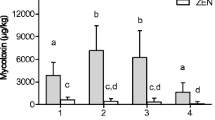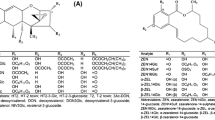Abstract
A Fusarium and Fusarium toxin monitoring programme has been established within the food and feed control authorities of Saxony-Anhalt for the 2001–2003 period. The first results of the deoxynivalenol analyses of cereals and cereal products with assured origin in this federal state, showed a contamination rate of 42% for wheat and wheat products. The contamination incidence reached only 14% in rye and rye products. Zearalenone couldn't be detected at all in the analyzed samples.
Similar content being viewed by others
References
European Commission (2000) Document SANCO/1630/00-rev 1.
Usleber E, Lepschy J, Märtlbauer, E (2000): Deoxynivalenol in Mehlproben des Jahres 1999 aus dem Einzelhandel. Mycotoxin Research 16A: 30–33.
European Commission — Scientific Committee on Food (1999) Opinion on Fusarium Toxins, Part 1: Deoxynivalenol (DON). Document SCF/CS/CNTM/MYC/19 Final 09/12/99.
Author information
Authors and Affiliations
Rights and permissions
About this article
Cite this article
Woese, K. Monitoring of deoxynivalenol and zearalenone in cereals and cereal products from the state of Saxony-Anhalt, Germany. Mycotox Res 17 (Suppl 1), 45–48 (2001). https://doi.org/10.1007/BF03036710
Published:
Issue Date:
DOI: https://doi.org/10.1007/BF03036710




